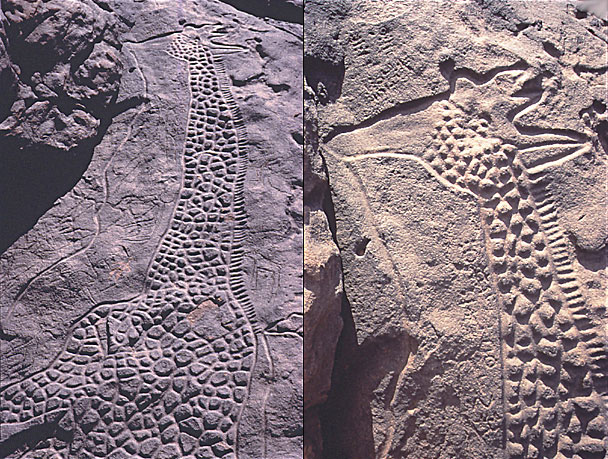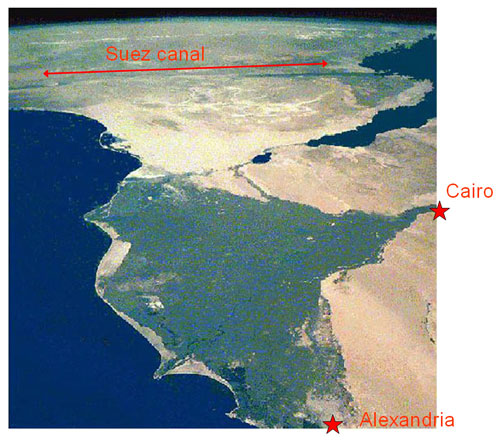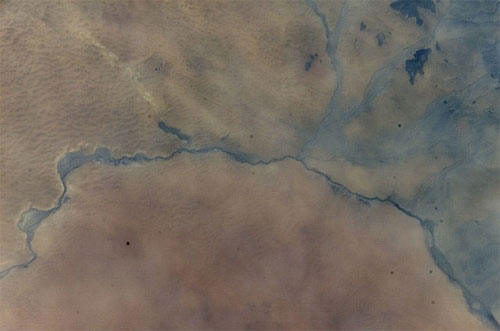Modern Dry Phase
The time period between 5500 and 3500 BC was one of tremendous climate change - all of it toward dryer conditions. During this transformation, the grass and scrub vanished, the game animals migrated, and the hunters and (eventually) cattlemen who were abundant around the many lakes of the region abandoned their lifestyle and took to a combination of (a) nomadic raiding and (b) settling along the Nile valley. This climatological change marks the start of centralized residential civilization. We have great records of the changes in both climate and life style preserved in rock art from the modern Sahara. This site is where much of the art has been found; it represents the early home of peoples who settled Egypt.
The Bubalus Period (5500-3500 BC) is named for art that shows animals that later became extinct in the area, including the buffalo (Bubalus antiquus), elephant, rhino, and hippo. Men are shown armed with clubs, throwing sticks—but never spears.
This giraffe was carved during the Bubalus period on a rock face in Niger. The presence of this intricate carving tells us more than simply indicating the presence of giraffe in what is now an arid region. For a group of people to create artwork, they must have enough food. If food is scarce then everybody spends their time finding and preparing food, not carving images of animals into rock. And if you have ever tried to carve anything out of granite, you will know that these artists spent a lot of time working on their images.

20-foot tall giraffe, northeastern Niger, Bubalus Period. Source: David Coulson
Between 3500-2000 BC the life style in this region (the modern Sahara; we haven't settled in the Nile valley yet) changed to reflect a fully pastoral economy. That means we see images of cattle and rams, indicating herding activities, rather than only buffalo, giraffe and other game animals. We also find pottery, bows and arrows. The domestication of sheep and goats spread from the Sahara to Khartoum in the early 5th millennium, or about 4500 BC.
We'll talk about the arrival of the horse in more detail soon, in the context of the Egyptians, but I wanted to close the circle on rock art. The horse was apparently introduced about 1200 BC by people from Crete, who came as allies of the Libyans and hence enemies of the Egyptians.
This space shuttle image should look familiar to you, and I include it here as a reminder of how different life in the delta is today. There is a narrow strip of green and that is all—no buffalo, hippo or horses outside of the immediate green zone.

The Nile Delta today. Source: NASA
There were other rivers during the Holocene Wet Phase as well, not just the Nile. The image below shows Wadi Howar, a huge tributary to the Nile that was not known by modern peoples until this space shuttle image was taken about a decade ago. Since then researchers have visited sites along the paleo-river and discovered ample evidence of human habitation. Wadi Howar was 2700 km long, and it flowed from about 9500-4500 years ago, linking together a very richly settled area of lakes and springs. It was just one of several such large tributaries that formed a trans-continental drainage system that has long since disappeared.

Wadi Howar, Sudan. Source: NASA
These images show dramatically the evidence for climate change recorded in the artwork and artifacts of the desert.

Wadi Howar today. Source: David Haberla